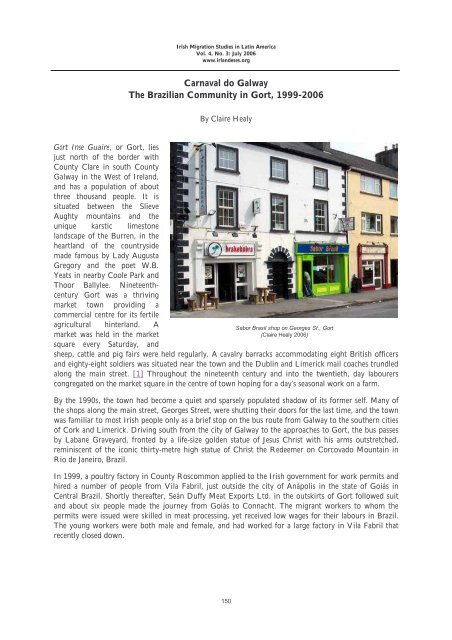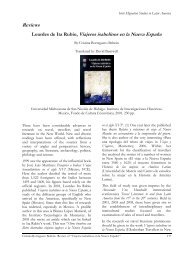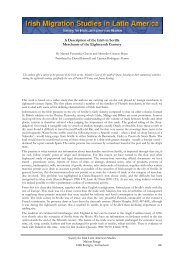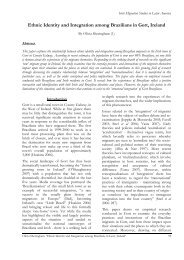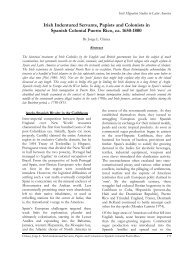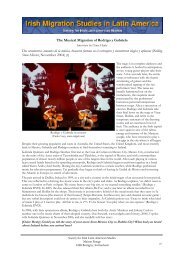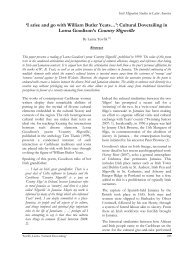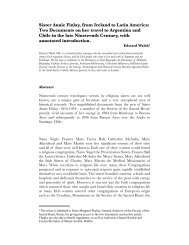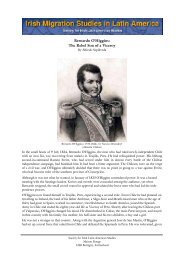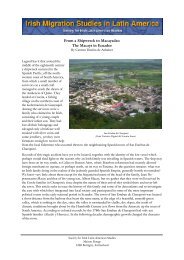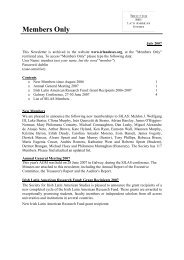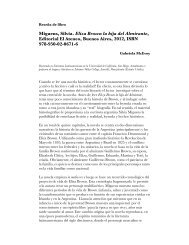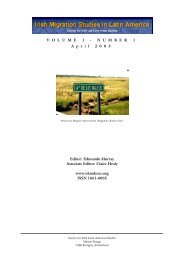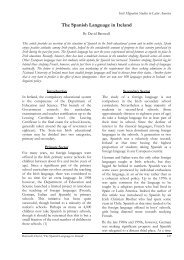Carnaval do Galway The Brazilian Community in Gort, 1999-2006
Carnaval do Galway The Brazilian Community in Gort, 1999-2006
Carnaval do Galway The Brazilian Community in Gort, 1999-2006
Create successful ePaper yourself
Turn your PDF publications into a flip-book with our unique Google optimized e-Paper software.
Irish Migration Studies <strong>in</strong> Lat<strong>in</strong> AmericaVol. 4, No. 3: July <strong>2006</strong>www.irlandeses.orgBil<strong>in</strong>gual <strong>Community</strong> Newsletter, Issue 2 (coverillustration)Initially the migrants spoke very little English, butthose who have rema<strong>in</strong>ed <strong>in</strong> <strong>Gort</strong> for the last sevenyears have become fluent <strong>in</strong> the language. <strong>The</strong> laterarrivals still have many difficulties <strong>in</strong> communicat<strong>in</strong>gwith the <strong>Gort</strong> locals and this leads to a myria<strong>do</strong>f problems <strong>in</strong> relation access to health services,education and other social facilities. While most ofthe <strong>Brazilian</strong>s who have set up families <strong>in</strong> <strong>Gort</strong>have married with<strong>in</strong> their own community, there isa small but grow<strong>in</strong>g level of <strong>in</strong>termarriage between<strong>Brazilian</strong> and Irish people <strong>in</strong> the town.Many travelled to <strong>Gort</strong> <strong>in</strong>tend<strong>in</strong>g to stay for a fewyears, work hard and earn enough money to returnto Goiás to build a house, start their own bus<strong>in</strong>essor send their children to school. Though manycame as s<strong>in</strong>gle people, or left their spouses andchildren beh<strong>in</strong>d, members of their families haves<strong>in</strong>ce jo<strong>in</strong>ed them <strong>in</strong> <strong>Gort</strong>. Those among thecommunity who hail from urban areas <strong>in</strong> Brazil such as Anápolis and São Paulo value the relative safetythat rural Ireland offers for their children. <strong>The</strong> ensu<strong>in</strong>g seven years have resulted <strong>in</strong> a demographicrevolution <strong>in</strong> the small <strong>Galway</strong> town, the population of which is currently estimated to be between 25and 30 per cent <strong>Brazilian</strong>-born. <strong>The</strong>re are signs that, as is the case <strong>in</strong> most migrant communities, some ofthe <strong>Brazilian</strong>s <strong>in</strong> <strong>Gort</strong> are there to stay.By Autumn 2004, when Duffy’s was seriously damaged by a fire, at least fifty <strong>Brazilian</strong> people werework<strong>in</strong>g at the plant. Fortunately no-one was <strong>in</strong>jured. [2] Still today a significant proportion of the staffof Duffy’s are <strong>Brazilian</strong> and signs <strong>in</strong> the factory are pr<strong>in</strong>ted <strong>in</strong> both English and Portuguese. Seán Duffyconsiders them to be reliable, diligent workers and he provides English classes to his Portuguesespeak<strong>in</strong>gemployees. [3] A conflagration was aga<strong>in</strong> the reason for a tragedy among <strong>Gort</strong>’s <strong>Brazilian</strong>community <strong>in</strong> early December 2005. Two young <strong>Brazilian</strong> men, Roberto Perna Ramos, aged 27, and hisuncle Erli Rodrigues da Silva, aged 43, died <strong>in</strong> their sleep when the build<strong>in</strong>g <strong>in</strong> which they were liv<strong>in</strong>gburnt <strong>do</strong>wn. <strong>The</strong> local <strong>Gort</strong> community of Irish and <strong>Brazilian</strong> people collected enough money <strong>in</strong> thewake of the tragedy to repatriate the men’s rema<strong>in</strong>s, and to contribute to the purchase of a house <strong>in</strong>Brazil for each of their families. [4]A large community of <strong>Brazilian</strong>s now live, work and attend school <strong>in</strong> <strong>Gort</strong>, gradually alter<strong>in</strong>g theappearance and the character of the town. A Pentecostal congregation, the Assembléia de Deus, has setup a church <strong>in</strong> the area and the community holds their own carnaval every Summer. <strong>The</strong>re is also a<strong>Brazilian</strong> Catholic community <strong>in</strong> the town, m<strong>in</strong>istered to by a Limerick-based priest Fr. Seán Lawler,who says mass <strong>in</strong> Portuguese every Sunday <strong>in</strong> <strong>Gort</strong> Catholic Church. <strong>The</strong> local football team has naturallybenefited from <strong>Brazilian</strong> talent and experience, while the ma<strong>in</strong> thoroughfare now boasts two<strong>Brazilian</strong> shops, “Sabor Brasil” on Georges Street and “Real Brazil” on Crowe Street, where <strong>Brazilian</strong>sand other customers can purchase Guaraná dr<strong>in</strong>ks, palm hearts, <strong>Brazilian</strong> coffee, feijão and other necessities.<strong>The</strong> local fruit and vegetable shop, “<strong>Gort</strong> Country Market,” run by Paul Walsh, stocks a wide varietyof reasonably priced <strong>Brazilian</strong> fruit and vegetables, such as p<strong>in</strong>to beans and mandioca (cassava) andadvertises its discount prices <strong>in</strong> both English and Portuguese. <strong>The</strong> shop also imports refrigerated productsfrom Brazil, via Lon<strong>do</strong>n, <strong>in</strong>clud<strong>in</strong>g pão de queijo (cheese bread) and polpas de frutas (fruit pulps).Recently local cha<strong>in</strong> supermarkets have also begun to stock <strong>Brazilian</strong> products.<strong>The</strong> occupational distribution of the community has now diversified, with a number of <strong>Brazilian</strong>swork<strong>in</strong>g <strong>in</strong> the retail, cater<strong>in</strong>g, construction and transport sectors, as well as <strong>in</strong> Duffy’s. <strong>The</strong>y currentlyHealy, Claire. <strong>Carnaval</strong> <strong>do</strong> <strong>Galway</strong>: the <strong>Brazilian</strong> <strong>Community</strong> <strong>in</strong> <strong>Gort</strong>, <strong>1999</strong>-<strong>2006</strong> ......................... 151
Irish Migration Studies <strong>in</strong> Lat<strong>in</strong> AmericaVol. 4, No. 3: July <strong>2006</strong>www.irlandeses.orgaccount for about 40% of the rental market <strong>in</strong> <strong>Gort</strong>. Many are on temporary one-year employmentpermits and their cont<strong>in</strong>u<strong>in</strong>g right to live and work <strong>in</strong> Ireland is not assured, particularly <strong>in</strong> view of thelarge numbers of Eastern Europeanmigrants with unlimitedresidence compet<strong>in</strong>g for similarjobs.<strong>The</strong> comb<strong>in</strong>ed efforts of the Irishand <strong>Brazilian</strong> communities <strong>in</strong> <strong>Gort</strong>have resulted <strong>in</strong> the publication ofa bil<strong>in</strong>gual community newsletterwhich published its first issue <strong>in</strong>February <strong>2006</strong>. <strong>The</strong> newsletterprovides advertis<strong>in</strong>g, news ofevents and general news to thetown and surround<strong>in</strong>g parishes <strong>in</strong>English, Portuguese, and oftenwith a smatter<strong>in</strong>g of Irish thrown<strong>in</strong>. <strong>The</strong> community has been thesubject of <strong>do</strong>cumentaries by theGerman television station ARDfor its Weltspiegel programme andthe F<strong>in</strong>ancial Times Deutschland,and has featured on the Irishstation RTÉ’s programmes Ear tothe Ground and No Place LikeHome.<strong>Gort</strong> Country Market, Georges St,(Claire Healy <strong>2006</strong>)<strong>The</strong> Associação Brasileira de <strong>Gort</strong>, founded <strong>in</strong> October 2005, provides assistance, advice, health promotionand translation services to the community two days per week <strong>in</strong> the Family Resource Centre, and isstaffed by seven volunteers - four <strong>Brazilian</strong>s and three Irish people. [5] A <strong>Brazilian</strong> Women’s Group,“Amizade em Ação” (Friendship <strong>in</strong> Action) also meets once a week with a programme of talks, art,aerobics and group dynamics. [6] <strong>The</strong> local community school provides both courses <strong>in</strong> English as aforeign language for the <strong>Brazilian</strong> community, and Portuguese courses for the local community.Very few <strong>Brazilian</strong>s <strong>in</strong>tend to rema<strong>in</strong> and settle <strong>in</strong> <strong>Gort</strong>, yet one has a sense that the community is thereto stay and many may change their m<strong>in</strong>d as they build a life for themselves <strong>in</strong> the small market town, thepopulation of which is f<strong>in</strong>ally beg<strong>in</strong>n<strong>in</strong>g to return to its 1830s levels. At the market square people areaga<strong>in</strong> beg<strong>in</strong>n<strong>in</strong>g to congregate <strong>in</strong> the morn<strong>in</strong>gs <strong>in</strong> the hope of a day’s work, though they speak <strong>in</strong><strong>Brazilian</strong> Portuguese rather than <strong>in</strong> Irish or English. Accord<strong>in</strong>g to journalist Kathy Sheridan, some<strong>Brazilian</strong>s <strong>in</strong> Roscommon are now ‘<strong>do</strong><strong>in</strong>g what the Irish emigrants used to <strong>do</strong>: scout<strong>in</strong>g out jobs forsibl<strong>in</strong>gs and <strong>in</strong>-laws <strong>in</strong> places such as Athenry, <strong>Gort</strong> and Roscommon and advanc<strong>in</strong>g their fares ifnecessary.’ [7] By now some of <strong>Gort</strong>’s <strong>Brazilian</strong>s have lived and worked <strong>in</strong> Ireland long enough to obta<strong>in</strong>a permanent residence permit and it is clear that many of them will jo<strong>in</strong> the ranks of the ‘New Irish’ ofthe twenty-first century.Claire HealyNotesHealy, Claire. <strong>Carnaval</strong> <strong>do</strong> <strong>Galway</strong>: the <strong>Brazilian</strong> <strong>Community</strong> <strong>in</strong> <strong>Gort</strong>, <strong>1999</strong>-<strong>2006</strong> ......................... 152
Irish Migration Studies <strong>in</strong> Lat<strong>in</strong> AmericaVol. 4, No. 3: July <strong>2006</strong>www.irlandeses.org[1] <strong>Galway</strong> Rural Development, ‘Local History, <strong>Gort</strong>, County <strong>Galway</strong>’ on:http://www.gortonl<strong>in</strong>e.com/TouristGuide/<strong>Gort</strong>LocalHistory/<strong>Gort</strong>+Local+History.htm.[2] Ferrie, Liam (ed.). <strong>The</strong> Irish Emigrant Issue No. 922 (Oct 2004). Available onl<strong>in</strong>e at:http://www.emigrant.ie/article.asp?iCategoryID=177&iArticleID=35928[3] O’Brien, Carl. ‘“All this will enrich the culture”’ <strong>in</strong> ‘<strong>The</strong> New Irish,’ <strong>The</strong> Irish Times, 10 May 2004,p15.[4] ‘News’ <strong>in</strong>: Bil<strong>in</strong>gual <strong>Community</strong> Newsletter/Jornal Bil<strong>in</strong>gue da Comunidade, Issue 1, February <strong>2006</strong>,p4.[5] ‘<strong>The</strong> <strong>Brazilian</strong> Association of <strong>Gort</strong> - “Help<strong>in</strong>g <strong>Brazilian</strong>s to help themselves”’ <strong>in</strong> Bil<strong>in</strong>gual <strong>Community</strong>Newsletter/Jornal Bil<strong>in</strong>gue da Comunidade, Issue 1, February <strong>2006</strong>, pp12-13; Vieira, Nilton, ‘Imigração naEuropa: Entre a Necessidade e o Me<strong>do</strong>’ <strong>in</strong> Bil<strong>in</strong>gual <strong>Community</strong> Newsletter/Jornal Bil<strong>in</strong>gue da Comunidade,Issue 3, April <strong>2006</strong>, p5.[6] ‘Grupo para Mulheres: “Amizade em Ação” <strong>Brazilian</strong> Women’s Friendship Group’ <strong>in</strong> Bil<strong>in</strong>gual<strong>Community</strong> Newsletter/Jornal Bil<strong>in</strong>gue da Comunidade, Issue 1, February <strong>2006</strong>, p13; Enereh, Monica,‘Fique por dentro <strong>do</strong> que está acontecen<strong>do</strong> em nossa comunidade!!’ <strong>in</strong> Bil<strong>in</strong>gual <strong>Community</strong> Newsletter/JornalBil<strong>in</strong>gue da Comunidade, Issue 2, March <strong>2006</strong>, p14.[7] Sheridan, Kathy. ‘Grateful to God and Roscommon’ <strong>in</strong> ‘<strong>The</strong> New Irish, <strong>The</strong> Irish Times, 10 May2004, p15.References- Bil<strong>in</strong>gual <strong>Community</strong> Newsletter / Jornal Bil<strong>in</strong>gue da Comunidade for <strong>Gort</strong> and surround<strong>in</strong>g parishes. Issues1 (February <strong>2006</strong>), 2 (March <strong>2006</strong>) and 3 (April <strong>2006</strong>).- Ferrie, Liam (ed.), <strong>The</strong> Irish Emigrant, Issue No. 922 (Oct 2004). Available onl<strong>in</strong>e (www.emigrant.ie),accessed 9 April <strong>2006</strong>.- www.gortonl<strong>in</strong>e.com, accessed 7 April <strong>2006</strong>.- O’Brien, Carl, ‘“All this will enrich the culture”’ <strong>in</strong> ‘<strong>The</strong> New Irish,’ <strong>The</strong> Irish Times, 10 May 2004, p15.- Sheridan, Kathy, ‘Grateful to God and Roscommon’ <strong>in</strong> ‘<strong>The</strong> New Irish,’ <strong>The</strong> Irish Times, 10 May 2004,p15.Healy, Claire. <strong>Carnaval</strong> <strong>do</strong> <strong>Galway</strong>: the <strong>Brazilian</strong> <strong>Community</strong> <strong>in</strong> <strong>Gort</strong>, <strong>1999</strong>-<strong>2006</strong> ......................... 153


